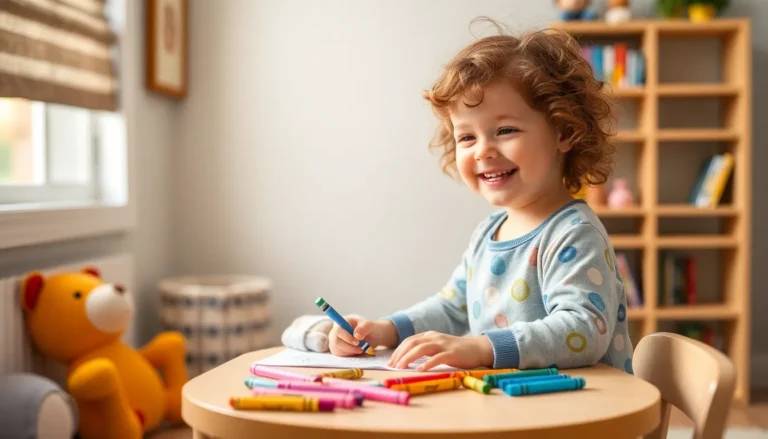Table of Contents
ToggleChildhood trauma can feel like an unwelcome guest that just won’t leave the party. It crashes into the most joyful moments, turning laughter into awkward silences and smiles into frowns. But what if recovery could be the ultimate party trick? With the right tools and support, it’s possible to dance away from the shadows of the past and reclaim that joy.
In this journey of healing, understanding the impact of childhood trauma is just the first step. It’s not about ignoring the past; it’s about learning to juggle those heavy emotions while still enjoying the show. With humor, resilience, and a sprinkle of professional guidance, anyone can turn their story into a powerful narrative of strength and hope. Let’s dive into the world of childhood trauma recovery and discover how to transform pain into purpose.
Understanding Childhood Trauma
Childhood trauma significantly affects emotional and psychological development. Recognizing its nature and types is crucial for effective recovery.
Definition of Childhood Trauma
Childhood trauma involves harmful experiences during formative years. These experiences may include physical, emotional, or psychological harm. Trauma can arise from abuse, neglect, or exposure to violence, profoundly impacting a child’s development. This impact often extends into adulthood, manifesting as anxiety, depression, or relationship difficulties. Acknowledging trauma’s definition helps in understanding its varying effects on individuals.
Types of Childhood Trauma
Types of childhood trauma encompass several specific experiences. Abuse, subdivided into physical, emotional, and sexual forms, represents extreme harm inflicted on a child. Neglect includes the absence of necessary care, which can lead to feelings of abandonment. Witnessing domestic violence or experiencing community violence can also cause significant trauma. Natural disasters and family separations create additional traumatic experiences. Each type of trauma carries its unique challenges and recovery pathways, underscoring the need for a tailored healing approach.
The Impact of Childhood Trauma

Childhood trauma significantly influences an individual’s emotional and physical well-being. Understanding these effects lays the groundwork for effective recovery.
Emotional Consequences
Emotional consequences of childhood trauma manifest in various ways. Individuals often experience anxiety, depression, and mood swings as a result of unresolved trauma. Trust issues may also emerge, creating barriers in relationships. Difficulty regulating emotions can lead to impulsiveness or withdrawal. Many individuals find it challenging to cope with stress and may display symptoms of post-traumatic stress disorder (PTSD). Healing emotional wounds requires acknowledgment, therapy, and support.
Physical Health Implications
Physical health implications of childhood trauma are equally concerning. Numerous studies link trauma to chronic health issues, such as heart disease and obesity. The body’s stress response can trigger inflammation, affecting overall health. Individuals may also experience sleep disturbances, which contribute to fatigue and reduced immunity. Long-term trauma impacts hormonal balance, leading to metabolic disorders. Addressing these physical aspects during recovery is crucial for comprehensive healing.
Pathways to Recovery
Recovery from childhood trauma involves various avenues tailored to individual needs. These pathways include therapeutic approaches and support systems, essential for fostering healing and growth.
Therapeutic Approaches
Therapeutic approaches play a crucial role in recovery. Cognitive-behavioral therapy (CBT) helps individuals reframe negative thoughts linked to traumatic experiences. Dialectical behavior therapy (DBT) focuses on emotion regulation and interpersonal effectiveness. EMDR, or eye movement desensitization and reprocessing, offers techniques to process and integrate traumatic memories. Mindfulness practices promote present-moment awareness, reducing anxiety and fostering emotional resilience. In therapy, consistency and communication are vital; clients benefit from open discussions about their experiences, leading to personalized healing strategies.
Support Systems
Support systems greatly influence the recovery process. Strong relationships with family and friends provide emotional validation and encouragement. Community support groups offer shared experiences and understanding, often creating a sense of belonging. Understanding and compassionate mentors can guide individuals through their journeys. Professional support from counselors or psychologists reinforces healing efforts. Consistent engagement with these networks enhances resilience and empowers individuals to navigate their trauma, fostering a sense of normalcy and hope in their lives.
Coping Strategies for Individuals
Individuals recovering from childhood trauma can implement various coping strategies. These approaches support emotional and physical healing.
Mindfulness and Self-Care
Mindfulness techniques improve emotional awareness and regulation. Practicing meditation or deep breathing helps individuals focus on the present moment, reducing anxiety. Engaging in regular exercise enhances mood and overall health. Nutrition also plays a vital role in recovery; a balanced diet provides essential nutrients for brain function. Individuals often find pleasure in creative activities such as writing, painting, or music, which facilitate expression and healing. Connecting with nature through walks or gardening can also promote serenity and mindfulness.
Building Resilience
Resilience is crucial for coping with the aftermath of trauma. Developing problem-solving skills empowers individuals to navigate challenges effectively. Establishing daily routines fosters a sense of stability and control. Cultivating positive relationships strengthens support systems, enhancing emotional well-being. Individuals can benefit from journaling, allowing them to reflect on their experiences and emotions. Setting achievable goals promotes motivation and encourages progress in the healing journey. By embracing these strategies, individuals build resilience and chart a path toward recovery.
The Role of Family and Community
Family and community play vital roles in childhood trauma recovery. Supportive relationships foster resilience and contribute to long-term healing.
Supportive Family Dynamics
Healthy family dynamics provide a foundation for recovery. Open communication allows individuals to express emotions without fear of judgment. Families that prioritize understanding create safe spaces for healing. Active involvement from family members encourages a collective approach to addressing trauma. Additionally, consistent emotional support helps maintain motivation during challenging times. Celebrating small victories as a family reinforces progress and strengthens bonds.
Community Resources
Community resources enhance recovery efforts, offering diverse support options. Local support groups connect individuals with shared experiences, fostering a sense of belonging. Educational programs can equip families with tools to cope effectively. Therapists and counselors within the community provide professional guidance tailored to specific needs. Access to workshops promoting mental health awareness equips individuals with strategies for resilience. Engaging in community activities fosters a supportive environment, reducing feelings of isolation.
Recovery from childhood trauma is a journey filled with hope and resilience. By embracing therapeutic tools and building strong support systems, individuals can transform their pain into strength. The process encourages acknowledging emotions while fostering joy and connection.
Through mindfulness practices and creative expression, healing becomes a path to self-discovery and growth. Families and communities play a vital role in this journey, offering the support needed to navigate challenges. Celebrating progress, no matter how small, reinforces the belief that a brighter future is possible.
Ultimately, the journey of recovery is unique for everyone, but the potential for healing and personal growth remains universal.







